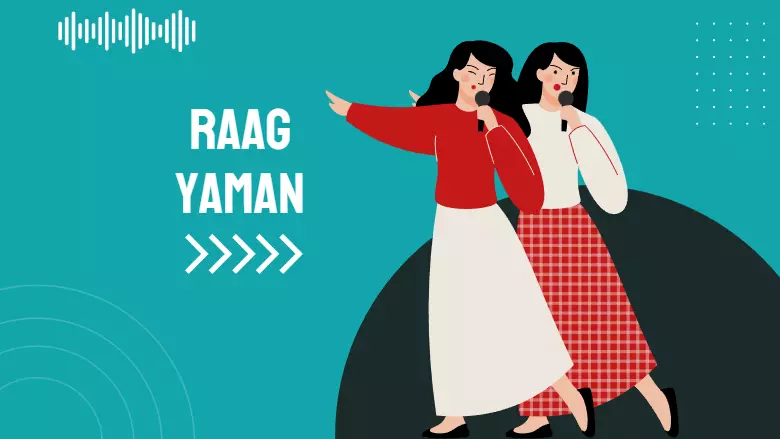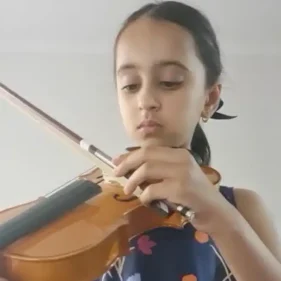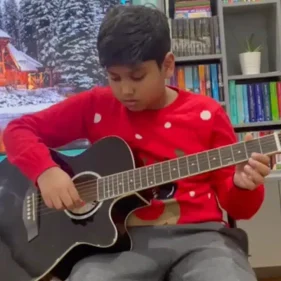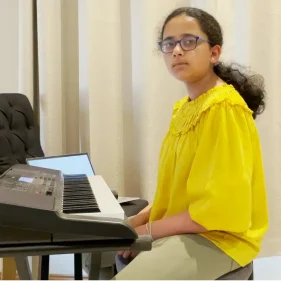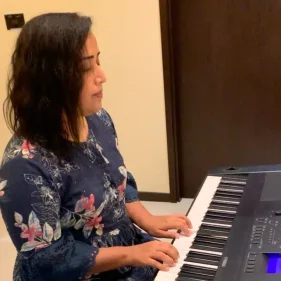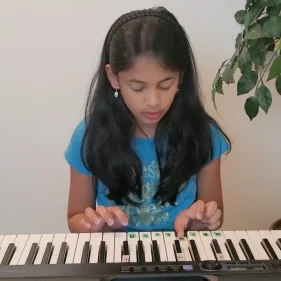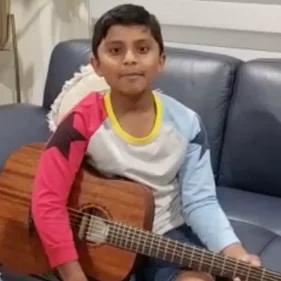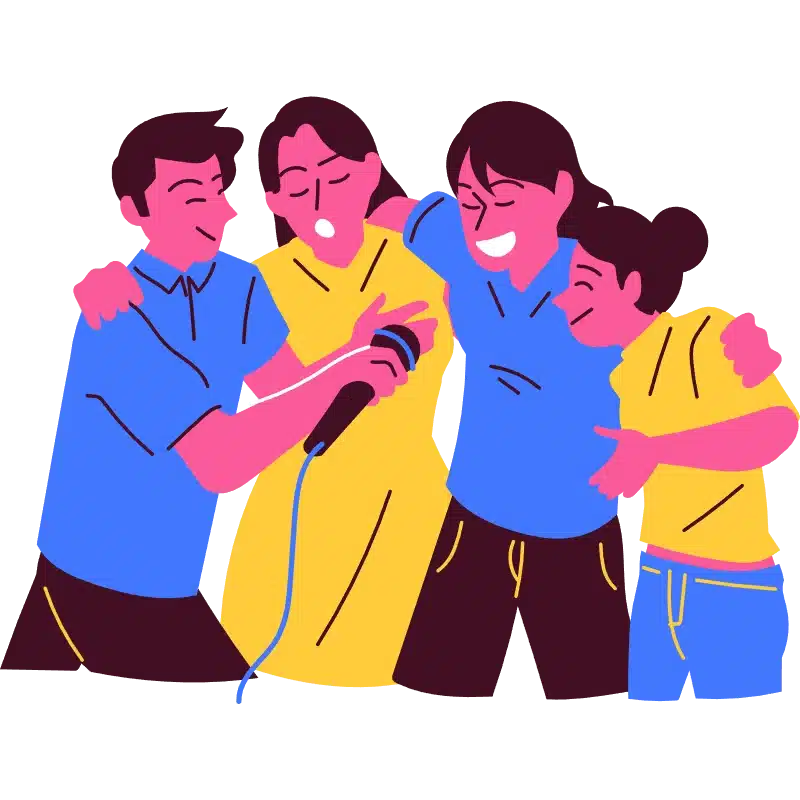- Technical Details
- Raag Yaman Notations
- Bandish for Practice
- Raag Yaman Sargam for Practice
- Raag Yaman’ Lakshan Geet
- Mood of Raag Yaman
- Origin of Raag Yaman
- Organization and Relationship
- Popular Bollywood Raag Yaman Songs & Related Compositions
- More Raag Yaman Based Songs
- Ghar Se Nikalte Hi
- Chandan Sa Badan Chanchal Chitwan
- Jab Deep Jale Aana
- Ehsan Tera Hoga Mujh Par
- Laal Ishq
- Woh Jab Yaad Aaye
- Paan Khaye Saiyan Hamaro
- FAQs
Raag Yaman was the first lesson I learnt when I started my Hindustani singing journey 15+ years back. Yaman (also known as Kalyan, Iman, Aiman, “Eman”, “Kalyani” in Carnatic Classical music) is regarded as one of the grandest, most fundamental Ragas in Hindustani music. Also this is one of the first Raag taught to students. The original name of Raag Yaman is Raag Kalyan and only during the Mughal’s rule the name Yaman was introduced and used thereafter. Raag Yaman emerged from the parent musical scale of Kalyan and is rendered at the time when lights are put on.
If you are new to Hindustani music, this is the first Raag you can learn and this Raag is considered one of the most important in all of Hindustani Sangeet. It is the primary Raag in Kalyan which in itself is a primary Thaat. The importance of Yaman can easily be seen in the fact that it is one of the first Raag to be taught. Indeed many traditions teach it before Bilawal thaat. In this blog we will look into Raag Yaman songs and notes with tips to practice.
Technical Details
The structure of Raag Yaman is classical music is quite simple. It has all shuddha swaras except for the tivra Ma which gives this Raag its distinctive quality of peace and tranquility. The Raag Yaman notes are considered analogous to the western Lydian mode. The jati of this Raag is sampurna-sampurna as both ascending (Arohana) and descending (Avrohana) of this Raag includes all seven Yaman Raag notes in an octave.
Sometimes, this Raag is also considered as audav-sampoorna because of its other singing style, the structure of which includes Ni, Re Ga ma Dha Ni Re’ Sa’, Ni Dha Pa ma Ga Re Sa. The fifth note (Pancham) is omitted in this style but the avroh is the same complete octave.
There are many rules that one must follow to showcase the true form of Raag Yaman. The Vadi Swar is Gandhar and Samvadi is Nishad. Therefore, if Gandhar is not given the utmost importance, another Raag may be portrayed instead. Similarly, without giving the second most prominence to Nishad, Yaman may not come into view completely.
Tonal movements of the Raag Yaman notes mostly reflect zigzag motion with gaps of one or several Yaman Raag notes usually that prefer reverse order very often like Dha Ni Sa, ma Dha Ni, Ga ma Dha, Re Ga ma,etc. Ideally, Yaman should not use Pa-Re combination but can use Pa-Re showing color of ma or Ga while gliding from Pa to Re, for Pa Re is one of the specific identification of Raag Kalyan.
Ragas in the Kalyan thaat are supposed to be sung during the first quarter of the night. Yaman Raag time or samay is 6 p.m. to 9 p.m.
Raag Yaman Notations
*Throughout the discussion, ma = tivra madhyam*
| Swaras | Madhyam Teevra, rest all Shuddha Swaras. |
| Jaati | Sampurna-Sampurna |
| Thaat | Kalyan |
| Vadi | Ga |
| Samvadi | Ni |
| Ideal time to sing | 6 p.m. to 9 p.m. ( 1st quarter of the night) |
| Vishranti Sthan | Sa, Ga, Ni. Sa’, Ni, Pa, Ga |
| Aroh | .Ni Re Sa – Ni Re Ga ma Pa Dha Ni Sa’ |
| Avroh | Sa’ Ni Dha Pa ma Ga Re Sa ,.Ni Re Sa |
| Pakad | .Ni Re Ga Re Sa, Pa ma Ga Re Sa |
Bandish for Practice
For a better understanding about the Raag, you can watch the following tutorial videos in order to learn Raag Yaman notes. The tutorial includes Raag Yaman’s aroh, avroh including the pakad of the Raag with a chota khayal in teen taal madhya laya along with a few taans. The tutorial is made in such a way that it becomes easier for beginners to learn the Raag, the links of which are as follows:
You can also refer to the following bandishes in order to know more pieces in this Raag.
Bandish 1: Tori re baasuriya
Check below the arohana and avarohana of Raag Yaman & Tori Re Baasuriya Bandish by one of our star Hindustani teachers Ms. Prakriti Sharma.
Tori re baasuriya jaadu bhari
Moh liyo man prem bhari
Bisar gayi sudh sun
Murli ko
Naahi parkey maika
Chain ek ghari
Tori re baasuriya jaadu bhari
moh liyo man prem bhari
Bandish 2 – Ae Ri Aali Piya Binu
Ae ri aali piya binu
Sakhi ae ri aali piya binu
Sakhi kal na parat mohe is ghare palchin
Ae ri aali piya binu
Sakhi ae ri aali piya binu
Jabse piya pardes gaye more
Ratiyan katat mori taare gin gin
Raag Yaman Sargam for Practice
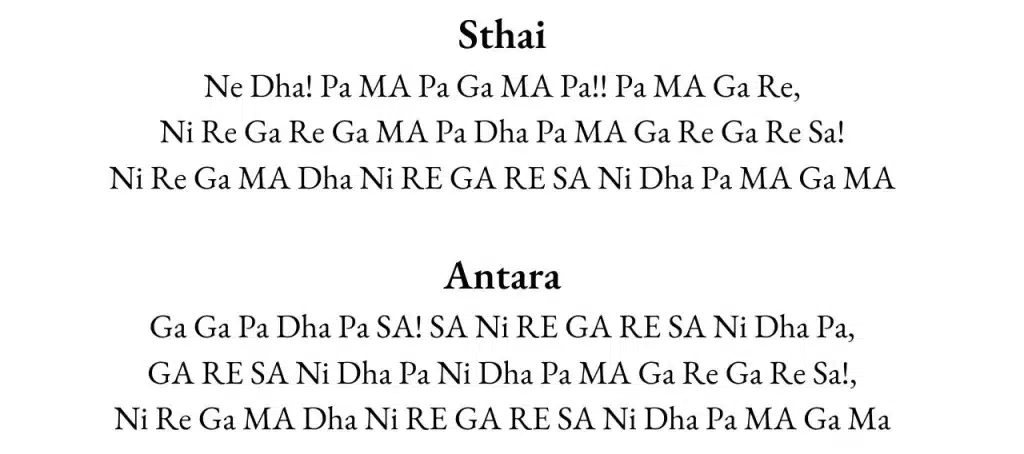
Raag Yaman’ Lakshan Geet
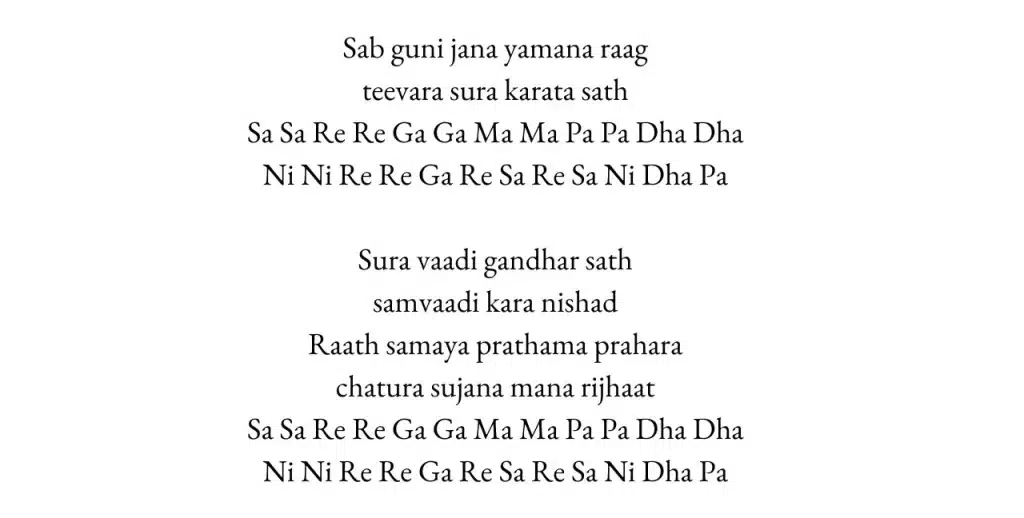
Tips to Practise
- Take it slow, set the tempo at a comfortable speed where you can sing the Raag Yaman notes comfortably. Also make sure you are comfortable with the pitch. You can sing in a pitch in which you are comfortable.
- Listen to the audio file of Raag Yaman taans as many times as possible and sing along with it. Make sure to stay on the pitch or Shruti. Use shrutibox to make sure you on right shruti. Staying in the pitch is the most important. Practise (Riyaz) the arohana and avarohana multiple number of times. Note these are the fundamental building blocks for your singing skills.
- Try to sing the bandish, at first it may not be as sweet as you want, but with practise over time please be assured that it will come out. Remember there is only one short cut – Practise, Practise & More Practise.
Mood of Raag Yaman
This Raag expresses ultimate humility and has an untainted appeal or urge of shaking off ego, haughtiness and arrogance. One can completely surrender one’s soul to the ultimate, through immersing in the ecstatic melody of Yaman.
Prayer and love are complementarily expressed through the rendition of the Raag just like the inseparable connection between the moon and moonbeam, or between fish and water. Both the artists and the audiences can reach absolute nothingness through meditating the Raag.
If the swar ‘re’ in Yaman turns komal, theRaagthen converts to Puriya Kalyan, of which Purbanga is ‘Purya’ and Uttaranga is ‘Yaman’; if the note ‘dha’ is made komal along with it, then the Raag formed is called Puriya Dhanashree.
Yaman is called the King of the entire Raag, while “Puriya Dhanashree” is termed as the King of the entire evening Raag. Yaman means the full moon. Hazrat Amir Khusrau composed the Raag at the time of Khilji dynasty. Hazrat Amir Khusrau (real name Abul Hasan) is the only one termed ‘Hazrat’ in the realm of Music; as he is the creator of Khayal, Ghazal, Raag Yaman, Gulnux (a genre of music), sitar, tabla and baya.
Raag Yaman is performed at a time when nature or the universe creates an ambience of complete surrender to the ultimate, after a hectic day. The Raag of Yaman emits when nature takes all the living beings in her lap with kindness and generosity. Yaman is a Raag through which one can purify oneself with the holy hum of evening prayer at a mosque, temple, pagoda or church. It is an evening Raag which is romantic in nature.
The Raag generates bhakti, gambhir, shringar, serene and suggestive Raga. Yaman is the defining Raag of its own thaat Kalyan, meaning the full moon. Similar Ragas are Yaman Kalyan and Maru Behag.
There are virtually limitless variations in this raag and each of them is so different that one thinks the canvas of this raag is as colossal as the horizon. The deeper you go, you find it fathomless; the higher you see, it remains dashingly over and above the rest of the world of music.
Beyond its aesthetic appeal, Raag Yaman holds deeper wisdom. It invites the listener to experience a state of profound inner reflection, connecting with their own emotions and the essence of the Raag. The repetitive and intricate melodic patterns of Yaman allow for introspection and a meditative state of mind.
The performance of Raag Yaman conveys a tone that is both joyous and vibrant while also being quiet, calm, and peaceful. Moreover it require a high level of skill, knowledge, and discipline. Musicians must master the intricacies of the Raag while bringing their own creativity and individual expression. This process fosters discipline, focus, and a deep understanding of the musical form, reflecting the wisdom of dedication, practice, and self-mastery.
In addition to its musical aspects, This Raag has been a source of inspiration for poets, writers, and philosophers as well. Its emotive qualities and ability to evoke a range of feelings have influenced various art forms and cultural expressions, amplifying its wisdom beyond the realm of music. It is also said that Raag Yaman has a certain influence on the human brain waves and hence is used in music therapy as well.
Origin of Raag Yaman
Its origins are obscure and there is a tendency to ascribe it to Persian origins, however this is doubtful for several reasons. The first evidence is to be found in its ancient and very secure position in carnatic sangeet. It is known as ‘Kalyani’ in this system. The second and most important piece of evidence is the fact that it appears to be modally identical to one of the old Jatis. Thus, when one realizes that this modal form existed in Greek music (Hypolydian mode), and music of the Middle east, it would be easy to ascribe this mode to proto-Indo-European origins. If this is the case, we are talking of a scale which antedates the concept of Raga by several thousand years.
Hindustani vocalist, scholar and researcher Ramkrishna Das Nadrang states that by name of the Raag Yaman, some musicians think its origin is from Yemen, a country in the Middle East at the southern end of the Arabian Peninsula due to phonetic similarities or linguistic coincidences but there is no direct historical link between them. The etymology of the word “Yaman” is believed to have originated from the sanskrit word “Yama”, which refers to the Hindu god of death.
By traditional restrictions of Gwalior gharana, some olden schools of Hindustani music, the masters of music think that a learner has to bring faith (IMAAN) to the words of a teacher-mentor to progress in music, thus they cherish “imaan laao (submit to the aphorism)” on the part of the students, thus music teaching is started with Yaman; as a result the name of Yaman was popular as imaan too, that is closer to term imaan.
Ramkrishna Das says that by another hypothesis, the word Yaman is close to Sanskrit Yavan (Muslim) that gave rise to Raag Yaman from Kalyan as puritan Hindu musicians preferred calling the melody as Yavanon ka Kalyan i.e. Kalyan of the Muslim artistes which got shortened to become Yavan Kalyan > Yaman Kalyan > Yaman. South Indian Carnatic music named Yaman like melody as yamuna Kalyani whereas Gwalior Paluskar tradition invented Raag Jaimini Kalyan perhaps to match with the Carnatic name.
In a sense, it was a derogatory term for melody of Yaman with mutilated the sanctity of Kalyan due to excessive zigzag tonal movements which projected downward intricate tonal movements with internal skips/gaps of Raag Yaman notes, for instance, ni re sa, ma re ga, ma dha pa, ga pa ma, re ma ga, ni sa ni, ga re ni, ni dha ma, ma dha ni, ni re ga, re pa ma, ni dha sa ni re sa ga re ma ga pa ma, ma dha ni ma re ni ma dha ni re sa, etc. Raag Yaman taans emphasizes ni, ga, ma along with quite a limited use of sa and pa in the ascent whereas Kalyan emphasizes sa, pa, re, ga with highly limited use of ma and ni. Raga Kalyan too, has frequent downward movements in the model of Raga shuddha Kalyan.
There are votaries of calling Yaman as the invention of Ameer Khusro (1253-1325), a Sufi saint poet, singer and courtier of several Indian rulers. Raag Vyakaran by Bimalakaanta Roychoudhury comprises four varieties of Yaman, of which Khusro’s Yaman has no ni, no tivra ma in ascent except ma ga ma. This melody is penta-hexatonic (Sa Re Ga Pa Dha Sa ‘| Sa’ Dha Pa Ga ma Ga Re Sa) with vadi ga and samvadi dha which shows that the present popular Yaman is much more different from the 14th century Yaman. According to Ramkrishna Das, contemporary Yaman is derivative of olden Raag Yamani that evolved by the bank of river Yamuna near Mathura – Vrindavan or Chaiti dhun (melody) of Varanasi. Most precisely Yaman seems to be part of Yamani due to the name of river Yamuna.
Hence, the precise origins of this Raag are difficult to trace as many Ragas have evolved and transformed over centuries through the oral tradition of transmission. However, it is believed to have been developed and refined by various musicians and composers throughout history.
Organization and Relationship
There is some discussion whether Yaman and Kalyan really just are different names for the same Raga, or that these are actually 2 Ragas. Joep Bor says “Kalyan (today usually referred to as Yaman)”, Kaufmann says that Yaman and Kalyan are just different names, but insists that Raga Yaman-Kalyan is different as natural Ma is occasionally inserted between two Ga, like Ga Ma Ga Re Sa, while in all other instances tivra Ma (Ma is used as in Kalyan). S. Bagchee agrees with Kaufmann.
As Bor, Kaufmann and Bagchee are not practicing, professional and traditional musicians or artists with training from qualified musicians for several hundred (+practicing) hours and knowing a few dozens of bandishes/ compositions of North Indian Hindustani classical music in Raga Yaman, thus their opinions and observations needs to be accepted with a pinch of salt.
A sensible analysis of large data of the Raga, honesty and truthful introspection lead any sane musicians to think, that the name of the Raag Yaman and Kalyan are different so their tonal movements shall be different for Kalyan is more akin to Shuddha Kalyan not Yaman in any case.
The influence of Kalyani of Carnatic and almost blind following of Pt. Bhatkhande as well as unquestionable trust and faith to guru (music teachers) caused this confusion. People erratically believe that if natural Ma is occasionally added in a concluding figure leading to Sa, the Raga is known as Yaman-Kalyan. Practically, Yaman has a rag-anga very much different from Kalyan rag-anga resembling colors of Shuddha Kalyan.
The use of shuddha ma must be restricted as a Vivadi swara (limited use) or grace note for Raag Yaman Kalyan otherwise there is a chance of it becoming Yamani, Yamani Bilawal, Jaimini Kalyan. Moreover, neither Kalyan or Yaman has Shuddha Ma in its main body thus use of shuddha Ma does not create Yaman Kalyan. Ideally there is no Raga at all in Indian music that is recognized as any type of Kalyan because of shuddha Ma, thus Raag Yaman Kalyan becomes a misnomer or pure lie because of Shuddha Ma in the tonal structure of Raag Yaman.
Kalyan is mixed with several Ragas that has either of Kalyan ang or Yaman ang.
- Adbhut Kalyan
- Anandi Kalyan
- Bhog Kalyan
- Bhoop Kalyan
- Bilas khani Kalyan
- Chandra Kalyan
- Chhaya Kalyan
- Deepak Kalyan
- Gaud Kalyan
- Gorakh Kalyan
- Hameer Kalyan
- Hem Kalyan
- Hindol Kalyan
- Husseini Kalyan
- Jaimini Kalyan
- Jait Kalyan
- Kamod Kalyan
- Kedar Kalyan
- Kesari Kalyan
- Khem Kalyan
- Kohri Kalyan
- Laxmi Kalyan
- Maru Kalyan
- Miyaan ki Kalyan
- Nand Kalyan
- Nat Kalyan
- Panch Kalyan
- Poorva Kalyan
- Puriya Kalyan
- Pyaar Kalyan
- Raam Kalyan
- Raini Kalyan
- Ravi Kalyan
- Saraswati Kalyan
- Shankar Kalyan
- Shankaraa Kalyan
- Shiv Kalyan
- Shree Kalyan
- Shuddha Kalyan
- Shyam Kalyan
- Sohni Kalyan
- Yaman Kalyan
Yaman Raag mixing in other Ragas.
- Kalavati Yaman
- Yaman Bhopali
- Yamani
- Yamani Basant
- Yamani Bilawal
- Yamani Hindol
- Yaman Chhaya
Concludingly, there is a considerable debate as to the very nature of the existence of this Raga. On one hand, we have a large and growing number of modernists who consider Yaman, Yaman-Kalyan and Kalyan to be one Raga. On the other hand, we have a shrinking number of traditionalists who view them as three distinct Ragas. Bhatkhande himself appears to have taken a middle view of Yaman being the main Raga with only Raag Yaman Kalyan notes being distinguished by the addition of a weak Shuddha Madhyam. Regardless of our views on these theoretical arguments, it is apparent that this Raga is going to be here for a long to come.
Popular Bollywood Raag Yaman Songs & Related Compositions
Here are some of the songs based on Raag Yaman. It has been frequently used in film songs including a duet Re Man Sur Mein Ga , recorded by Asha Bhosle and Manna Dey and Kuch Na Kaho, Kuch Bhi Na Kaho recorded by Kumar Sanu. Some other songs based on Raag Yaman are Aaye ho meri zindagi mein tum bahar banke , Abhi na jao chorh kar , Kabhi Kabhi Mere Dil Mein , Yun Shabnami , Aaj Ibadat (from the movie Bajirao Mastani) and Naam Gum Jayega.
Eminent artist Manna Dey’s record of the songs Sundori Go and Deep Chhilo Shikha Chhilo are also set on Raga Yaman.
A Tagore composition Dariye Achho Tumi Amar is set on Raag Yaman while our National Poet’s compositions Bulbuli Nirob Nargis Bone and Mone Porey Aj Se Kon Janome are evocative of this Raga.
Master vocalists including Bade Ghulam Ali Khan , Ustad Amir Khan , Pt. Bhimsen Joshi , Ustad Rashid Khan , Vidushi Dr. Ashwini Bhide Deshpande , Pandit Ajoy Chakrabarty , Pandit Tushar Dutta have showcased their musical prayers by performing Raga Yaman, alongside eminent instrumentalists including Ustad Vilayat Khan on Sitar , Pandit Hariprasad Chaurasia on Flute , Pandit Nikhil Banerjee on Sitar , Pandit Ravi Shankar on Sitar and Pandit Vishwa Mohan Bhatt on Mohan Veena.
The ghazals Aa Gayi Sham Dhalte Hi recorded by Ghulam Ali Ranjish Hi Sahi recorded by Mehdi Hassan and Chaand Angraiyan Le Raha Hai recorded by Anup Jalota are also based on Raga Yaman.
These are just a few examples, as Raag Yaman has been explored and interpreted by numerous composers and musicians in different styles and genres. Its versatility allows for a wide range of musical expressions, making it a favorite Raga for both classical and contemporary Raag Yaman compositions. It’s worth noting that the combinations and songs based on this Raag can vary and different artists may interpret the Raga with their unique melodic explorations and improvisations, adding their creative touch to the compositions.
More Raag Yaman Based Songs
Ghar Se Nikalte Hi
‘Ghar Se Nikalte Hi’ is a popular song in ‘Papa Kehte Hain’ based on Raag Yaman sargams. It has a smooth and light melody with catchy, meaningful lyrics. The composition sounds of this bollywood song based on Raag Yaman are traditional yet very sophisticated.
Chandan Sa Badan Chanchal Chitwan
This classic song has won many hearts. Based on Raag Yaman notations, ‘Chandan Sa Badan Chanchal Chitwan’ is featured in the movie ‘Saraswatichandra.’ The flowing musical phrases built around Raag Yaman aroh and avroh match the serene and divine nature of the lyrics.
Jab Deep Jale Aana
‘Jab Deep Jale Aana’ is one of the soulful bollywood songs based on Raag Yaman. The song’s gentle rhythm with classical instrumentation makes it evoke feelings of nostalgia and longing.
Ehsan Tera Hoga Mujh Par
Yet another one from the List of popular bollywood songs based on Raag Yaman. ‘Ehsan Tera Hoga Mujh Par.’ Sung by the great singer Mohemmad Rafi, this haunting melody has subtle percussion and a warm lyrical flow.
Laal Ishq
Beautiful melody blending the elements of Yaman Raag notes. I always admire the sound of sitar and tabla amidst the sounds of modern instrumentation. ‘Laal Ishq’ from ‘Goliyan Ki Raasleela Ram-Leela’ is one of the most celebrated bollywood songs based on Raag yaman.
Woh Jab Yaad Aaye
‘Woh Jab Yaad Aaye’ is a beautiful song from ‘Parasmani.’ It uses Raag Yaman sargams to express deep longing and memories of lost love. I must say that this soulful ballad stays memorable for thousands of music lovers.
Paan Khaye Saiyan Hamaro
‘Paan Khaye Saiyan Hamaro’ from the movie ‘Teri Kaasam’ is from the List of popular songs based on Raag Yaman.
FAQs
What does Raag Yaman signify?
Raag Yaman is a seven note scale in hindusani classical music, that signifies a range of emotions – happiness, serene, calmness, peace and devotion.
What is the mood of Raag Yaman?
The mood of raag yaman is peace, calmness, happiness and devotion.
Why is the Raag Yaman popular?
Raag Yaman is popular as it a beginner raag and can be mastered relatively easier. An artist can sing or play a variety of songs using this raag.
What are the rules of Raag Yaman?
The essence of this raag is in Ma, which should be sung on higher octave (Teevr Ma) and not as a flat note or Shudda Ma.
Related blog: Raag Bhairavi

